Understanding Contract Law: Elements, Types, and Liability Analysis
VerifiedAdded on 2020/01/23
|15
|4381
|63
Report
AI Summary
This report provides a comprehensive overview of contract law, beginning with the essential elements required for a valid contract, such as offer, acceptance, and free consent, and then exploring the different types of contracts including bilateral, unilateral, expressed, implied, and quasi contracts. The report delves into contract terms, differentiating between express and in-nominate terms, and examines the role of exemption clauses and conditions. It further analyzes the application of agreement components in business scenarios, providing case studies. The report also compares and contrasts contractual and tort liability, focusing on negligence and vicarious liability. The report concludes with real-world applications of these legal principles, enhancing the reader's understanding of contract law and its implications in business environments, with references to relevant case laws.
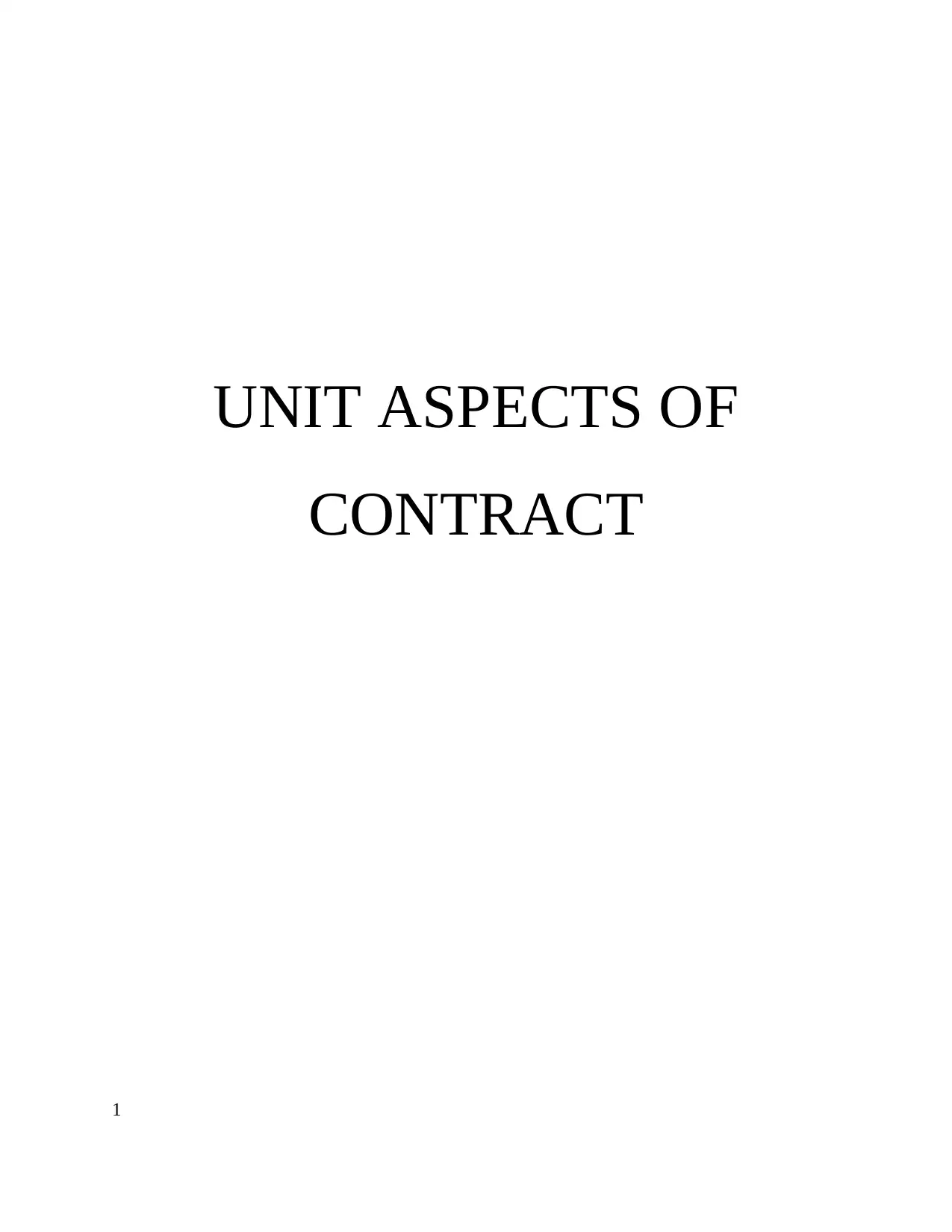
UNIT ASPECTS OF
CONTRACT
1
CONTRACT
1
Paraphrase This Document
Need a fresh take? Get an instant paraphrase of this document with our AI Paraphraser

2
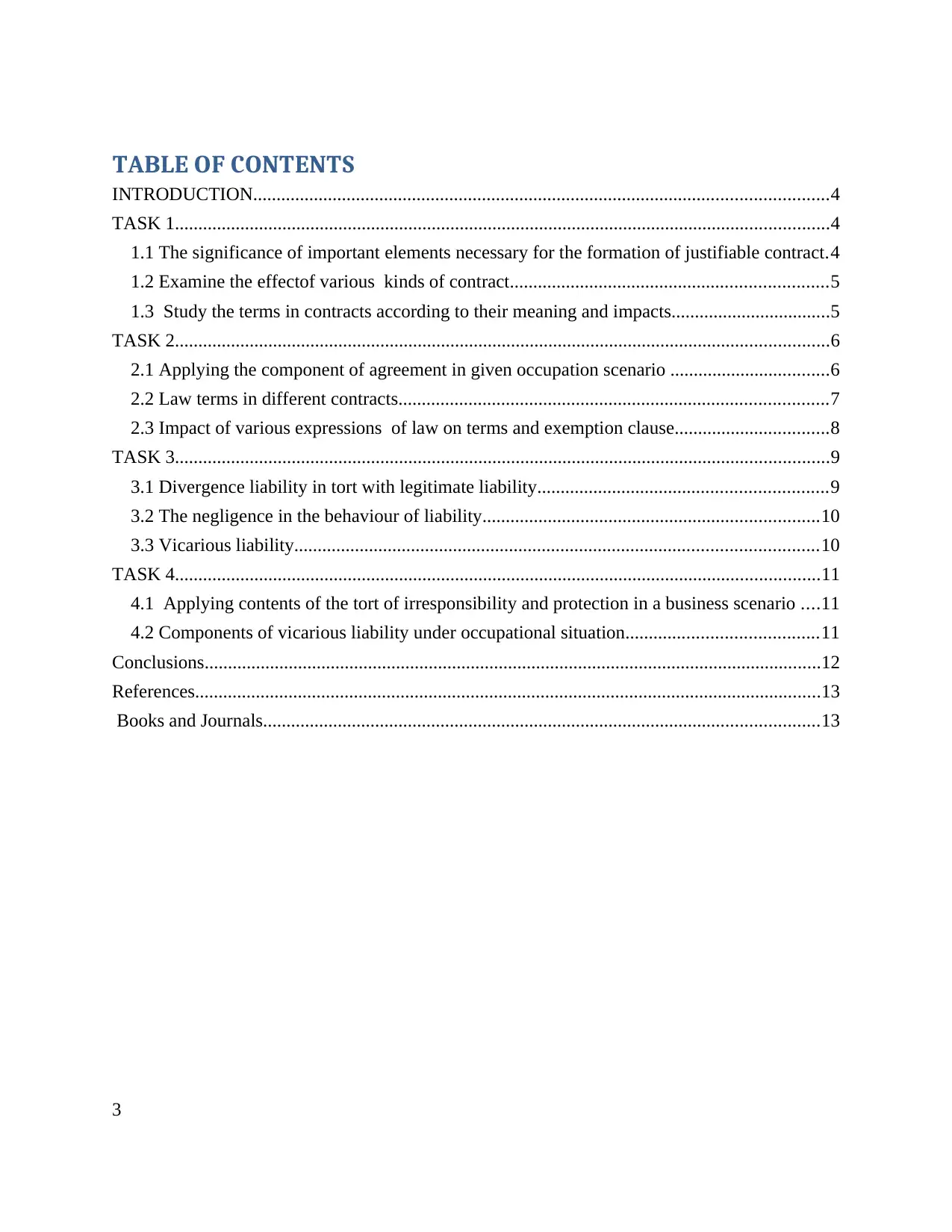
TABLE OF CONTENTS
INTRODUCTION...........................................................................................................................4
TASK 1............................................................................................................................................4
1.1 The significance of important elements necessary for the formation of justifiable contract.4
1.2 Examine the effectof various kinds of contract....................................................................5
1.3 Study the terms in contracts according to their meaning and impacts..................................5
TASK 2............................................................................................................................................6
2.1 Applying the component of agreement in given occupation scenario ..................................6
2.2 Law terms in different contracts............................................................................................7
2.3 Impact of various expressions of law on terms and exemption clause.................................8
TASK 3............................................................................................................................................9
3.1 Divergence liability in tort with legitimate liability..............................................................9
3.2 The negligence in the behaviour of liability........................................................................10
3.3 Vicarious liability................................................................................................................10
TASK 4..........................................................................................................................................11
4.1 Applying contents of the tort of irresponsibility and protection in a business scenario ....11
4.2 Components of vicarious liability under occupational situation.........................................11
Conclusions....................................................................................................................................12
References......................................................................................................................................13
Books and Journals.......................................................................................................................13
3
INTRODUCTION...........................................................................................................................4
TASK 1............................................................................................................................................4
1.1 The significance of important elements necessary for the formation of justifiable contract.4
1.2 Examine the effectof various kinds of contract....................................................................5
1.3 Study the terms in contracts according to their meaning and impacts..................................5
TASK 2............................................................................................................................................6
2.1 Applying the component of agreement in given occupation scenario ..................................6
2.2 Law terms in different contracts............................................................................................7
2.3 Impact of various expressions of law on terms and exemption clause.................................8
TASK 3............................................................................................................................................9
3.1 Divergence liability in tort with legitimate liability..............................................................9
3.2 The negligence in the behaviour of liability........................................................................10
3.3 Vicarious liability................................................................................................................10
TASK 4..........................................................................................................................................11
4.1 Applying contents of the tort of irresponsibility and protection in a business scenario ....11
4.2 Components of vicarious liability under occupational situation.........................................11
Conclusions....................................................................................................................................12
References......................................................................................................................................13
Books and Journals.......................................................................................................................13
3
⊘ This is a preview!⊘
Do you want full access?
Subscribe today to unlock all pages.

Trusted by 1+ million students worldwide
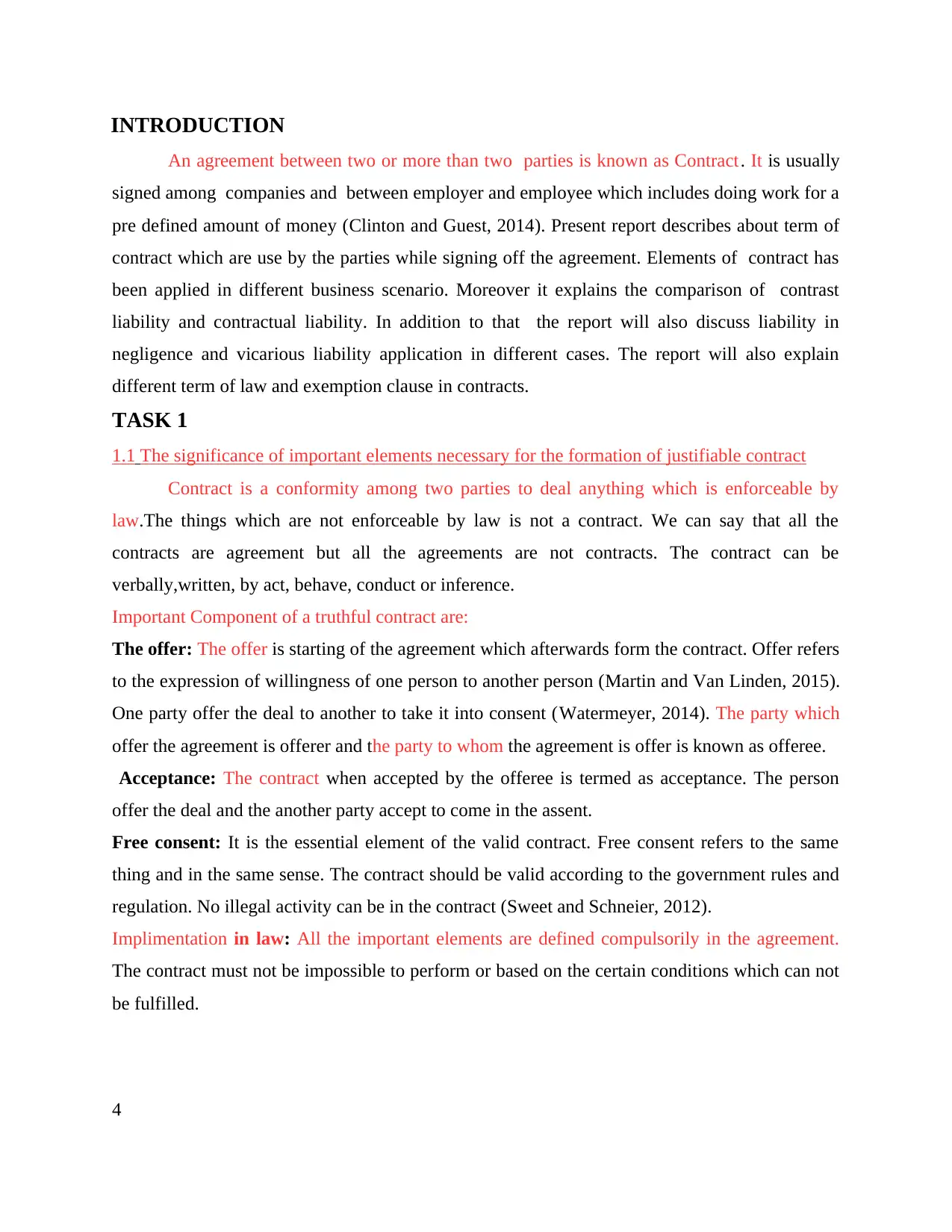
INTRODUCTION
An agreement between two or more than two parties is known as Contract. It is usually
signed among companies and between employer and employee which includes doing work for a
pre defined amount of money (Clinton and Guest, 2014). Present report describes about term of
contract which are use by the parties while signing off the agreement. Elements of contract has
been applied in different business scenario. Moreover it explains the comparison of contrast
liability and contractual liability. In addition to that the report will also discuss liability in
negligence and vicarious liability application in different cases. The report will also explain
different term of law and exemption clause in contracts.
TASK 1
1.1 The significance of important elements necessary for the formation of justifiable contract
Contract is a conformity among two parties to deal anything which is enforceable by
law.The things which are not enforceable by law is not a contract. We can say that all the
contracts are agreement but all the agreements are not contracts. The contract can be
verbally,written, by act, behave, conduct or inference.
Important Component of a truthful contract are:
The offer: The offer is starting of the agreement which afterwards form the contract. Offer refers
to the expression of willingness of one person to another person (Martin and Van Linden, 2015).
One party offer the deal to another to take it into consent (Watermeyer, 2014). The party which
offer the agreement is offerer and the party to whom the agreement is offer is known as offeree.
Acceptance: The contract when accepted by the offeree is termed as acceptance. The person
offer the deal and the another party accept to come in the assent.
Free consent: It is the essential element of the valid contract. Free consent refers to the same
thing and in the same sense. The contract should be valid according to the government rules and
regulation. No illegal activity can be in the contract (Sweet and Schneier, 2012).
Implimentation in law: All the important elements are defined compulsorily in the agreement.
The contract must not be impossible to perform or based on the certain conditions which can not
be fulfilled.
4
An agreement between two or more than two parties is known as Contract. It is usually
signed among companies and between employer and employee which includes doing work for a
pre defined amount of money (Clinton and Guest, 2014). Present report describes about term of
contract which are use by the parties while signing off the agreement. Elements of contract has
been applied in different business scenario. Moreover it explains the comparison of contrast
liability and contractual liability. In addition to that the report will also discuss liability in
negligence and vicarious liability application in different cases. The report will also explain
different term of law and exemption clause in contracts.
TASK 1
1.1 The significance of important elements necessary for the formation of justifiable contract
Contract is a conformity among two parties to deal anything which is enforceable by
law.The things which are not enforceable by law is not a contract. We can say that all the
contracts are agreement but all the agreements are not contracts. The contract can be
verbally,written, by act, behave, conduct or inference.
Important Component of a truthful contract are:
The offer: The offer is starting of the agreement which afterwards form the contract. Offer refers
to the expression of willingness of one person to another person (Martin and Van Linden, 2015).
One party offer the deal to another to take it into consent (Watermeyer, 2014). The party which
offer the agreement is offerer and the party to whom the agreement is offer is known as offeree.
Acceptance: The contract when accepted by the offeree is termed as acceptance. The person
offer the deal and the another party accept to come in the assent.
Free consent: It is the essential element of the valid contract. Free consent refers to the same
thing and in the same sense. The contract should be valid according to the government rules and
regulation. No illegal activity can be in the contract (Sweet and Schneier, 2012).
Implimentation in law: All the important elements are defined compulsorily in the agreement.
The contract must not be impossible to perform or based on the certain conditions which can not
be fulfilled.
4
Paraphrase This Document
Need a fresh take? Get an instant paraphrase of this document with our AI Paraphraser
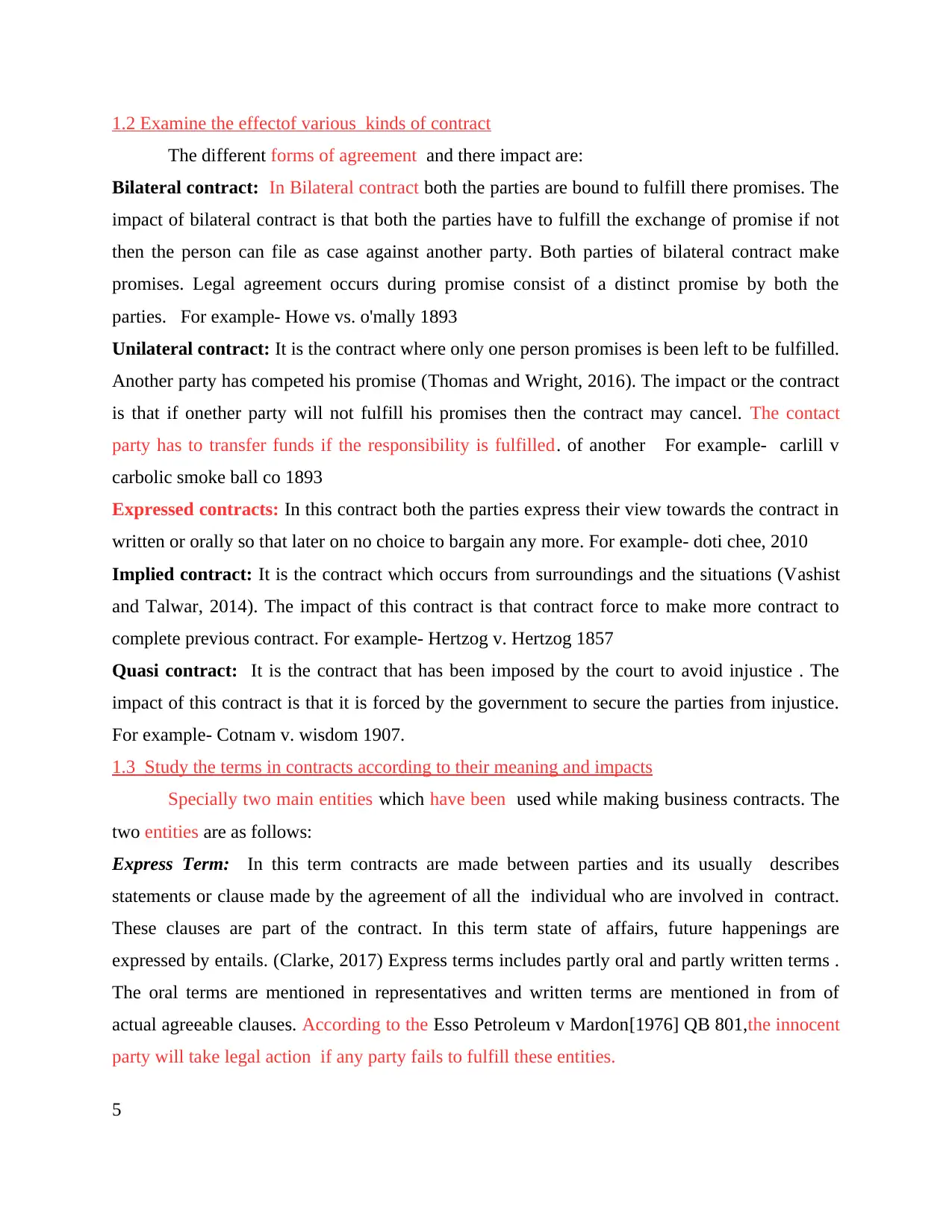
1.2 Examine the effectof various kinds of contract
The different forms of agreement and there impact are:
Bilateral contract: In Bilateral contract both the parties are bound to fulfill there promises. The
impact of bilateral contract is that both the parties have to fulfill the exchange of promise if not
then the person can file as case against another party. Both parties of bilateral contract make
promises. Legal agreement occurs during promise consist of a distinct promise by both the
parties. For example- Howe vs. o'mally 1893
Unilateral contract: It is the contract where only one person promises is been left to be fulfilled.
Another party has competed his promise (Thomas and Wright, 2016). The impact or the contract
is that if onether party will not fulfill his promises then the contract may cancel. The contact
party has to transfer funds if the responsibility is fulfilled. of another For example- carlill v
carbolic smoke ball co 1893
Expressed contracts: In this contract both the parties express their view towards the contract in
written or orally so that later on no choice to bargain any more. For example- doti chee, 2010
Implied contract: It is the contract which occurs from surroundings and the situations (Vashist
and Talwar, 2014). The impact of this contract is that contract force to make more contract to
complete previous contract. For example- Hertzog v. Hertzog 1857
Quasi contract: It is the contract that has been imposed by the court to avoid injustice . The
impact of this contract is that it is forced by the government to secure the parties from injustice.
For example- Cotnam v. wisdom 1907.
1.3 Study the terms in contracts according to their meaning and impacts
Specially two main entities which have been used while making business contracts. The
two entities are as follows:
Express Term: In this term contracts are made between parties and its usually describes
statements or clause made by the agreement of all the individual who are involved in contract.
These clauses are part of the contract. In this term state of affairs, future happenings are
expressed by entails. (Clarke, 2017) Express terms includes partly oral and partly written terms .
The oral terms are mentioned in representatives and written terms are mentioned in from of
actual agreeable clauses. According to the Esso Petroleum v Mardon[1976] QB 801,the innocent
party will take legal action if any party fails to fulfill these entities.
5
The different forms of agreement and there impact are:
Bilateral contract: In Bilateral contract both the parties are bound to fulfill there promises. The
impact of bilateral contract is that both the parties have to fulfill the exchange of promise if not
then the person can file as case against another party. Both parties of bilateral contract make
promises. Legal agreement occurs during promise consist of a distinct promise by both the
parties. For example- Howe vs. o'mally 1893
Unilateral contract: It is the contract where only one person promises is been left to be fulfilled.
Another party has competed his promise (Thomas and Wright, 2016). The impact or the contract
is that if onether party will not fulfill his promises then the contract may cancel. The contact
party has to transfer funds if the responsibility is fulfilled. of another For example- carlill v
carbolic smoke ball co 1893
Expressed contracts: In this contract both the parties express their view towards the contract in
written or orally so that later on no choice to bargain any more. For example- doti chee, 2010
Implied contract: It is the contract which occurs from surroundings and the situations (Vashist
and Talwar, 2014). The impact of this contract is that contract force to make more contract to
complete previous contract. For example- Hertzog v. Hertzog 1857
Quasi contract: It is the contract that has been imposed by the court to avoid injustice . The
impact of this contract is that it is forced by the government to secure the parties from injustice.
For example- Cotnam v. wisdom 1907.
1.3 Study the terms in contracts according to their meaning and impacts
Specially two main entities which have been used while making business contracts. The
two entities are as follows:
Express Term: In this term contracts are made between parties and its usually describes
statements or clause made by the agreement of all the individual who are involved in contract.
These clauses are part of the contract. In this term state of affairs, future happenings are
expressed by entails. (Clarke, 2017) Express terms includes partly oral and partly written terms .
The oral terms are mentioned in representatives and written terms are mentioned in from of
actual agreeable clauses. According to the Esso Petroleum v Mardon[1976] QB 801,the innocent
party will take legal action if any party fails to fulfill these entities.
5
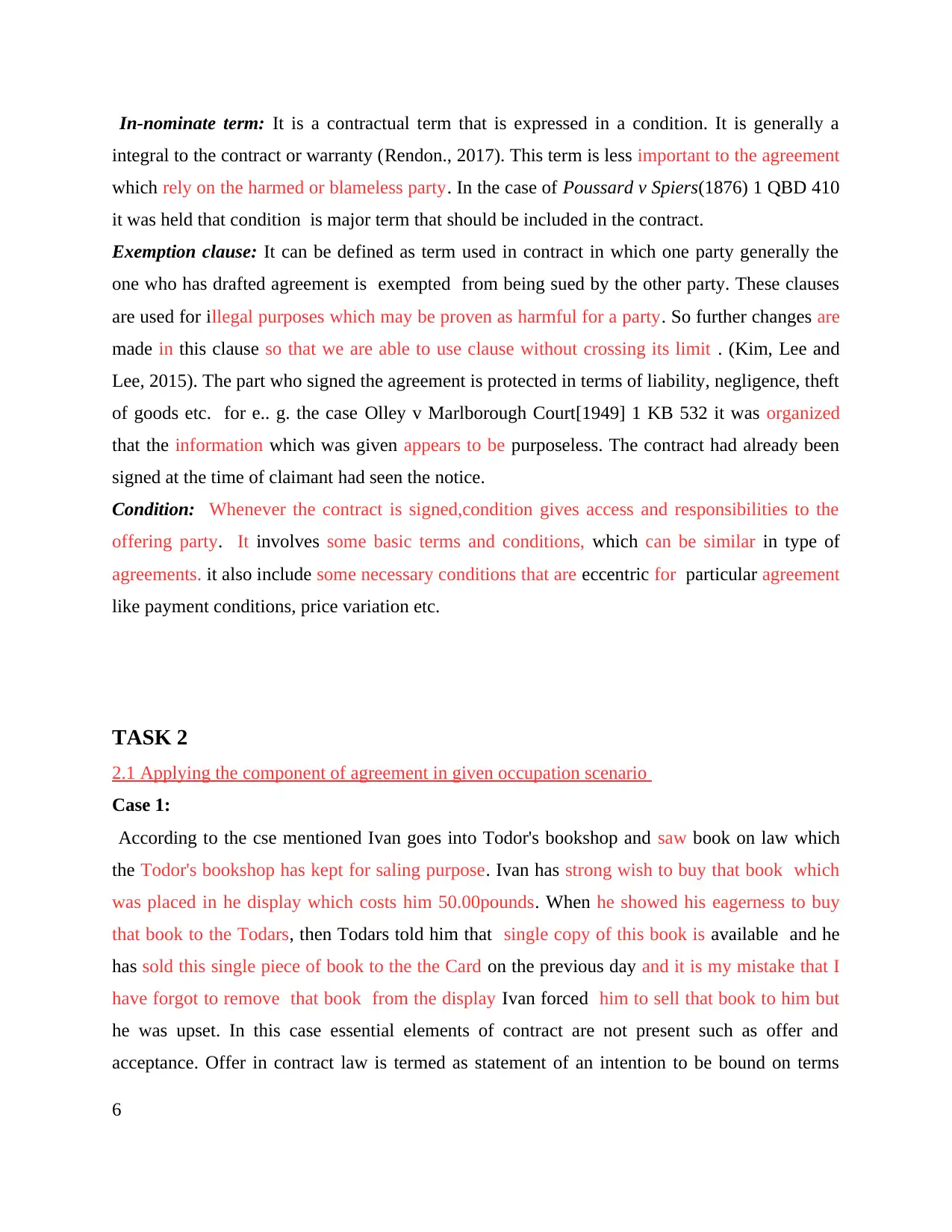
In-nominate term: It is a contractual term that is expressed in a condition. It is generally a
integral to the contract or warranty (Rendon., 2017). This term is less important to the agreement
which rely on the harmed or blameless party. In the case of Poussard v Spiers(1876) 1 QBD 410
it was held that condition is major term that should be included in the contract.
Exemption clause: It can be defined as term used in contract in which one party generally the
one who has drafted agreement is exempted from being sued by the other party. These clauses
are used for illegal purposes which may be proven as harmful for a party. So further changes are
made in this clause so that we are able to use clause without crossing its limit . (Kim, Lee and
Lee, 2015). The part who signed the agreement is protected in terms of liability, negligence, theft
of goods etc. for e.. g. the case Olley v Marlborough Court[1949] 1 KB 532 it was organized
that the information which was given appears to be purposeless. The contract had already been
signed at the time of claimant had seen the notice.
Condition: Whenever the contract is signed,condition gives access and responsibilities to the
offering party. It involves some basic terms and conditions, which can be similar in type of
agreements. it also include some necessary conditions that are eccentric for particular agreement
like payment conditions, price variation etc.
TASK 2
2.1 Applying the component of agreement in given occupation scenario
Case 1:
According to the cse mentioned Ivan goes into Todor's bookshop and saw book on law which
the Todor's bookshop has kept for saling purpose. Ivan has strong wish to buy that book which
was placed in he display which costs him 50.00pounds. When he showed his eagerness to buy
that book to the Todars, then Todars told him that single copy of this book is available and he
has sold this single piece of book to the the Card on the previous day and it is my mistake that I
have forgot to remove that book from the display Ivan forced him to sell that book to him but
he was upset. In this case essential elements of contract are not present such as offer and
acceptance. Offer in contract law is termed as statement of an intention to be bound on terms
6
integral to the contract or warranty (Rendon., 2017). This term is less important to the agreement
which rely on the harmed or blameless party. In the case of Poussard v Spiers(1876) 1 QBD 410
it was held that condition is major term that should be included in the contract.
Exemption clause: It can be defined as term used in contract in which one party generally the
one who has drafted agreement is exempted from being sued by the other party. These clauses
are used for illegal purposes which may be proven as harmful for a party. So further changes are
made in this clause so that we are able to use clause without crossing its limit . (Kim, Lee and
Lee, 2015). The part who signed the agreement is protected in terms of liability, negligence, theft
of goods etc. for e.. g. the case Olley v Marlborough Court[1949] 1 KB 532 it was organized
that the information which was given appears to be purposeless. The contract had already been
signed at the time of claimant had seen the notice.
Condition: Whenever the contract is signed,condition gives access and responsibilities to the
offering party. It involves some basic terms and conditions, which can be similar in type of
agreements. it also include some necessary conditions that are eccentric for particular agreement
like payment conditions, price variation etc.
TASK 2
2.1 Applying the component of agreement in given occupation scenario
Case 1:
According to the cse mentioned Ivan goes into Todor's bookshop and saw book on law which
the Todor's bookshop has kept for saling purpose. Ivan has strong wish to buy that book which
was placed in he display which costs him 50.00pounds. When he showed his eagerness to buy
that book to the Todars, then Todars told him that single copy of this book is available and he
has sold this single piece of book to the the Card on the previous day and it is my mistake that I
have forgot to remove that book from the display Ivan forced him to sell that book to him but
he was upset. In this case essential elements of contract are not present such as offer and
acceptance. Offer in contract law is termed as statement of an intention to be bound on terms
6
⊘ This is a preview!⊘
Do you want full access?
Subscribe today to unlock all pages.

Trusted by 1+ million students worldwide
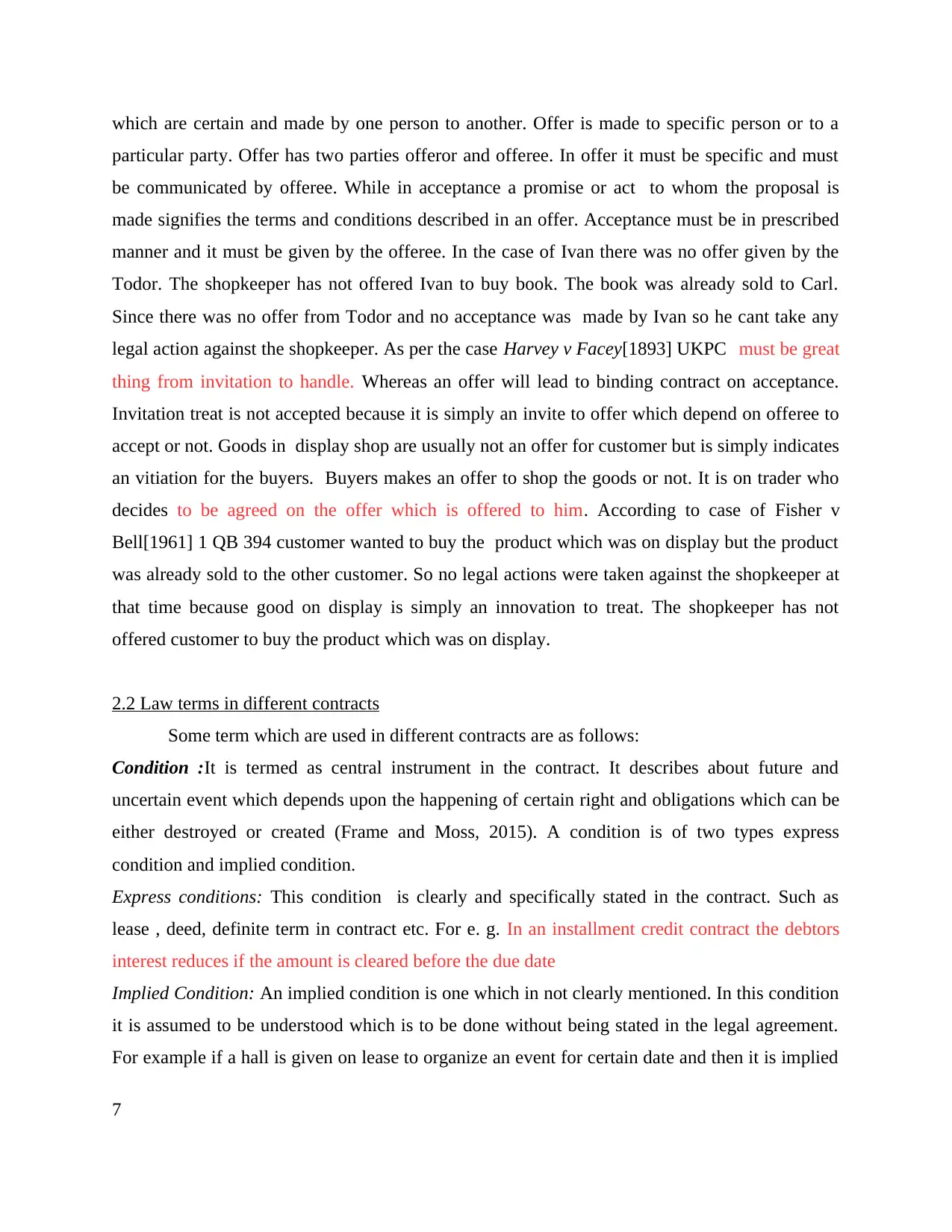
which are certain and made by one person to another. Offer is made to specific person or to a
particular party. Offer has two parties offeror and offeree. In offer it must be specific and must
be communicated by offeree. While in acceptance a promise or act to whom the proposal is
made signifies the terms and conditions described in an offer. Acceptance must be in prescribed
manner and it must be given by the offeree. In the case of Ivan there was no offer given by the
Todor. The shopkeeper has not offered Ivan to buy book. The book was already sold to Carl.
Since there was no offer from Todor and no acceptance was made by Ivan so he cant take any
legal action against the shopkeeper. As per the case Harvey v Facey[1893] UKPC must be great
thing from invitation to handle. Whereas an offer will lead to binding contract on acceptance.
Invitation treat is not accepted because it is simply an invite to offer which depend on offeree to
accept or not. Goods in display shop are usually not an offer for customer but is simply indicates
an vitiation for the buyers. Buyers makes an offer to shop the goods or not. It is on trader who
decides to be agreed on the offer which is offered to him. According to case of Fisher v
Bell[1961] 1 QB 394 customer wanted to buy the product which was on display but the product
was already sold to the other customer. So no legal actions were taken against the shopkeeper at
that time because good on display is simply an innovation to treat. The shopkeeper has not
offered customer to buy the product which was on display.
2.2 Law terms in different contracts
Some term which are used in different contracts are as follows:
Condition :It is termed as central instrument in the contract. It describes about future and
uncertain event which depends upon the happening of certain right and obligations which can be
either destroyed or created (Frame and Moss, 2015). A condition is of two types express
condition and implied condition.
Express conditions: This condition is clearly and specifically stated in the contract. Such as
lease , deed, definite term in contract etc. For e. g. In an installment credit contract the debtors
interest reduces if the amount is cleared before the due date
Implied Condition: An implied condition is one which in not clearly mentioned. In this condition
it is assumed to be understood which is to be done without being stated in the legal agreement.
For example if a hall is given on lease to organize an event for certain date and then it is implied
7
particular party. Offer has two parties offeror and offeree. In offer it must be specific and must
be communicated by offeree. While in acceptance a promise or act to whom the proposal is
made signifies the terms and conditions described in an offer. Acceptance must be in prescribed
manner and it must be given by the offeree. In the case of Ivan there was no offer given by the
Todor. The shopkeeper has not offered Ivan to buy book. The book was already sold to Carl.
Since there was no offer from Todor and no acceptance was made by Ivan so he cant take any
legal action against the shopkeeper. As per the case Harvey v Facey[1893] UKPC must be great
thing from invitation to handle. Whereas an offer will lead to binding contract on acceptance.
Invitation treat is not accepted because it is simply an invite to offer which depend on offeree to
accept or not. Goods in display shop are usually not an offer for customer but is simply indicates
an vitiation for the buyers. Buyers makes an offer to shop the goods or not. It is on trader who
decides to be agreed on the offer which is offered to him. According to case of Fisher v
Bell[1961] 1 QB 394 customer wanted to buy the product which was on display but the product
was already sold to the other customer. So no legal actions were taken against the shopkeeper at
that time because good on display is simply an innovation to treat. The shopkeeper has not
offered customer to buy the product which was on display.
2.2 Law terms in different contracts
Some term which are used in different contracts are as follows:
Condition :It is termed as central instrument in the contract. It describes about future and
uncertain event which depends upon the happening of certain right and obligations which can be
either destroyed or created (Frame and Moss, 2015). A condition is of two types express
condition and implied condition.
Express conditions: This condition is clearly and specifically stated in the contract. Such as
lease , deed, definite term in contract etc. For e. g. In an installment credit contract the debtors
interest reduces if the amount is cleared before the due date
Implied Condition: An implied condition is one which in not clearly mentioned. In this condition
it is assumed to be understood which is to be done without being stated in the legal agreement.
For example if a hall is given on lease to organize an event for certain date and then it is implied
7
Paraphrase This Document
Need a fresh take? Get an instant paraphrase of this document with our AI Paraphraser

that person has to take care of the property he has taken on lease. If hall burns down before the
due date then law would imply a condition where person has to pay for the whole property. It is
simply understood for buyer but not mentioned in the agreement.
Warranty: Warranty is promise made by either a manufacturer of seller. It is a legal binding
assurance that a good customer is buying if it is for use as explained, product is free from defect,
product meets the authorized specifications. A warranty explains the condition under which the
vendor or shopkeeper will repair , replaces the goods or return the amount of the good he has
charged. Customer can claim fro the money he has paid under the warranty's term an conditions.
It also specify T&C for both the parties in case of claim and dispute. For e. g. the case of UK
Leaf v International Galleries[1950] 2 KB 86 where the blunders are the basis of claims. The
claim does not get success due to the mistake related to quality did not render the subject. The
claim was different from the subject.
In-nominate term: It is synonym of Contractual term as it results in some conditions and
warranty. This term is incidental to the contract. It depends on the innocent party or injure party.
In this term breach does no t give rise to treat. This term is only used for damages and other
remedies such as specific performance.
2.3 Impact of various expressions of law on terms and exemption clause
Case 2: in this case the John goes to the park which is controlled by local council. In the park
he saws the board which is giving information which states that chairs to sit in park is given for
50p per hour. He payed 50p to the council and got the ticket and chair by parking attendants.
Later the chair collapsed under him which harmed him him and his clothes. John complained
about this event to the attendants an claimed for the compensation from council but the
attendants shows him the exemption clause of the ticket which says the authority is not
responsible fro any of such events of nay hired thing from the council. In this case exemption
clause is present, due to which John can take legal actions against the council. According to the
case Curtis v Chemical Cleaning Co [1951] 1 KB 805 the plaintiff has given dress to be make
ready by the a accused persons . She has signed a receipt after the assistant has told him that it
immune the cleaners from liability of damage. When dress was returned to her it was badly
stained. When she claimed for this the decision was taken that cleaners cannot be forgiven for
the the damage they have done to the clothes. due to exemption clause. Similarly in the case of
8
due date then law would imply a condition where person has to pay for the whole property. It is
simply understood for buyer but not mentioned in the agreement.
Warranty: Warranty is promise made by either a manufacturer of seller. It is a legal binding
assurance that a good customer is buying if it is for use as explained, product is free from defect,
product meets the authorized specifications. A warranty explains the condition under which the
vendor or shopkeeper will repair , replaces the goods or return the amount of the good he has
charged. Customer can claim fro the money he has paid under the warranty's term an conditions.
It also specify T&C for both the parties in case of claim and dispute. For e. g. the case of UK
Leaf v International Galleries[1950] 2 KB 86 where the blunders are the basis of claims. The
claim does not get success due to the mistake related to quality did not render the subject. The
claim was different from the subject.
In-nominate term: It is synonym of Contractual term as it results in some conditions and
warranty. This term is incidental to the contract. It depends on the innocent party or injure party.
In this term breach does no t give rise to treat. This term is only used for damages and other
remedies such as specific performance.
2.3 Impact of various expressions of law on terms and exemption clause
Case 2: in this case the John goes to the park which is controlled by local council. In the park
he saws the board which is giving information which states that chairs to sit in park is given for
50p per hour. He payed 50p to the council and got the ticket and chair by parking attendants.
Later the chair collapsed under him which harmed him him and his clothes. John complained
about this event to the attendants an claimed for the compensation from council but the
attendants shows him the exemption clause of the ticket which says the authority is not
responsible fro any of such events of nay hired thing from the council. In this case exemption
clause is present, due to which John can take legal actions against the council. According to the
case Curtis v Chemical Cleaning Co [1951] 1 KB 805 the plaintiff has given dress to be make
ready by the a accused persons . She has signed a receipt after the assistant has told him that it
immune the cleaners from liability of damage. When dress was returned to her it was badly
stained. When she claimed for this the decision was taken that cleaners cannot be forgiven for
the the damage they have done to the clothes. due to exemption clause. Similarly in the case of
8
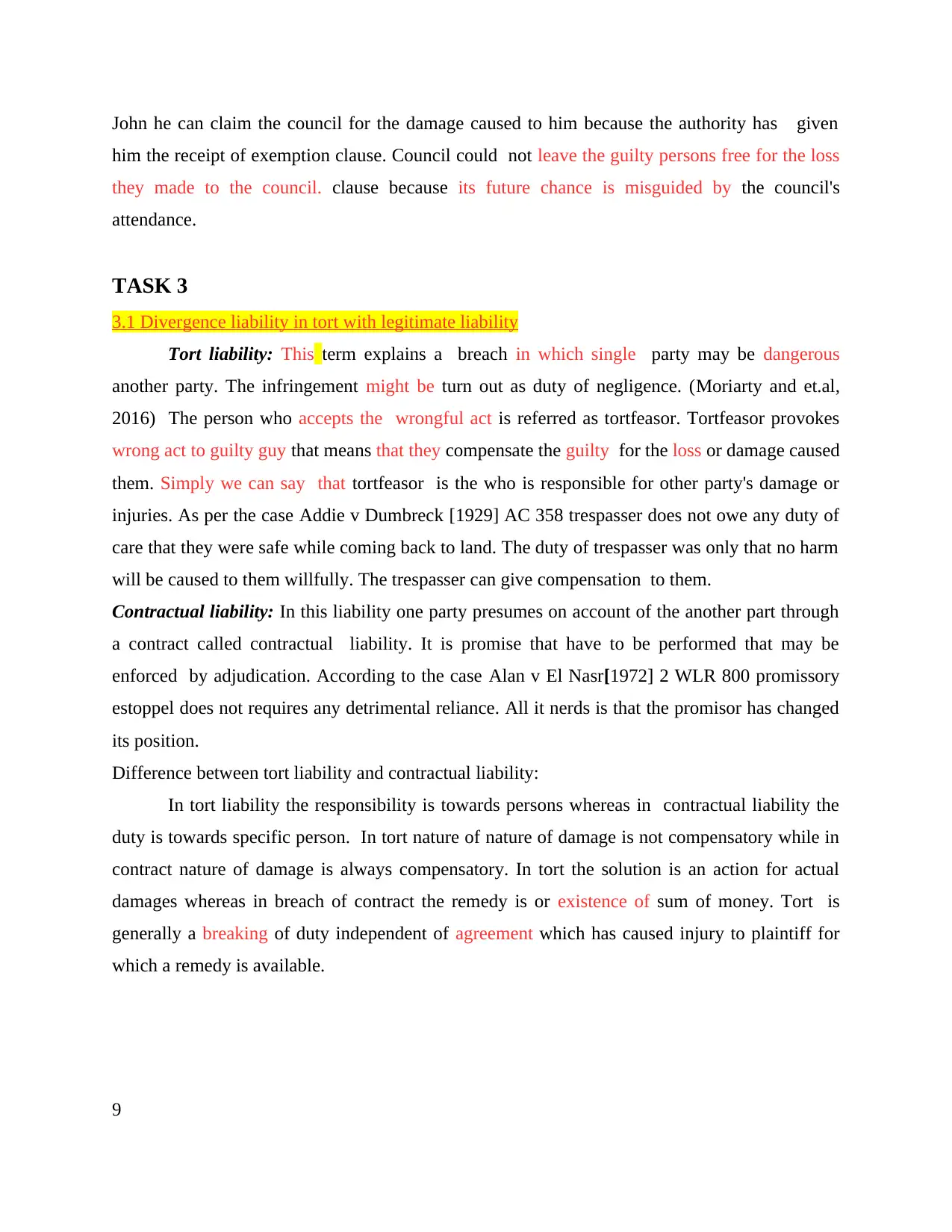
John he can claim the council for the damage caused to him because the authority has given
him the receipt of exemption clause. Council could not leave the guilty persons free for the loss
they made to the council. clause because its future chance is misguided by the council's
attendance.
TASK 3
3.1 Divergence liability in tort with legitimate liability
Tort liability: This term explains a breach in which single party may be dangerous
another party. The infringement might be turn out as duty of negligence. (Moriarty and et.al,
2016) The person who accepts the wrongful act is referred as tortfeasor. Tortfeasor provokes
wrong act to guilty guy that means that they compensate the guilty for the loss or damage caused
them. Simply we can say that tortfeasor is the who is responsible for other party's damage or
injuries. As per the case Addie v Dumbreck [1929] AC 358 trespasser does not owe any duty of
care that they were safe while coming back to land. The duty of trespasser was only that no harm
will be caused to them willfully. The trespasser can give compensation to them.
Contractual liability: In this liability one party presumes on account of the another part through
a contract called contractual liability. It is promise that have to be performed that may be
enforced by adjudication. According to the case Alan v El Nasr[1972] 2 WLR 800 promissory
estoppel does not requires any detrimental reliance. All it nerds is that the promisor has changed
its position.
Difference between tort liability and contractual liability:
In tort liability the responsibility is towards persons whereas in contractual liability the
duty is towards specific person. In tort nature of nature of damage is not compensatory while in
contract nature of damage is always compensatory. In tort the solution is an action for actual
damages whereas in breach of contract the remedy is or existence of sum of money. Tort is
generally a breaking of duty independent of agreement which has caused injury to plaintiff for
which a remedy is available.
9
him the receipt of exemption clause. Council could not leave the guilty persons free for the loss
they made to the council. clause because its future chance is misguided by the council's
attendance.
TASK 3
3.1 Divergence liability in tort with legitimate liability
Tort liability: This term explains a breach in which single party may be dangerous
another party. The infringement might be turn out as duty of negligence. (Moriarty and et.al,
2016) The person who accepts the wrongful act is referred as tortfeasor. Tortfeasor provokes
wrong act to guilty guy that means that they compensate the guilty for the loss or damage caused
them. Simply we can say that tortfeasor is the who is responsible for other party's damage or
injuries. As per the case Addie v Dumbreck [1929] AC 358 trespasser does not owe any duty of
care that they were safe while coming back to land. The duty of trespasser was only that no harm
will be caused to them willfully. The trespasser can give compensation to them.
Contractual liability: In this liability one party presumes on account of the another part through
a contract called contractual liability. It is promise that have to be performed that may be
enforced by adjudication. According to the case Alan v El Nasr[1972] 2 WLR 800 promissory
estoppel does not requires any detrimental reliance. All it nerds is that the promisor has changed
its position.
Difference between tort liability and contractual liability:
In tort liability the responsibility is towards persons whereas in contractual liability the
duty is towards specific person. In tort nature of nature of damage is not compensatory while in
contract nature of damage is always compensatory. In tort the solution is an action for actual
damages whereas in breach of contract the remedy is or existence of sum of money. Tort is
generally a breaking of duty independent of agreement which has caused injury to plaintiff for
which a remedy is available.
9
⊘ This is a preview!⊘
Do you want full access?
Subscribe today to unlock all pages.

Trusted by 1+ million students worldwide
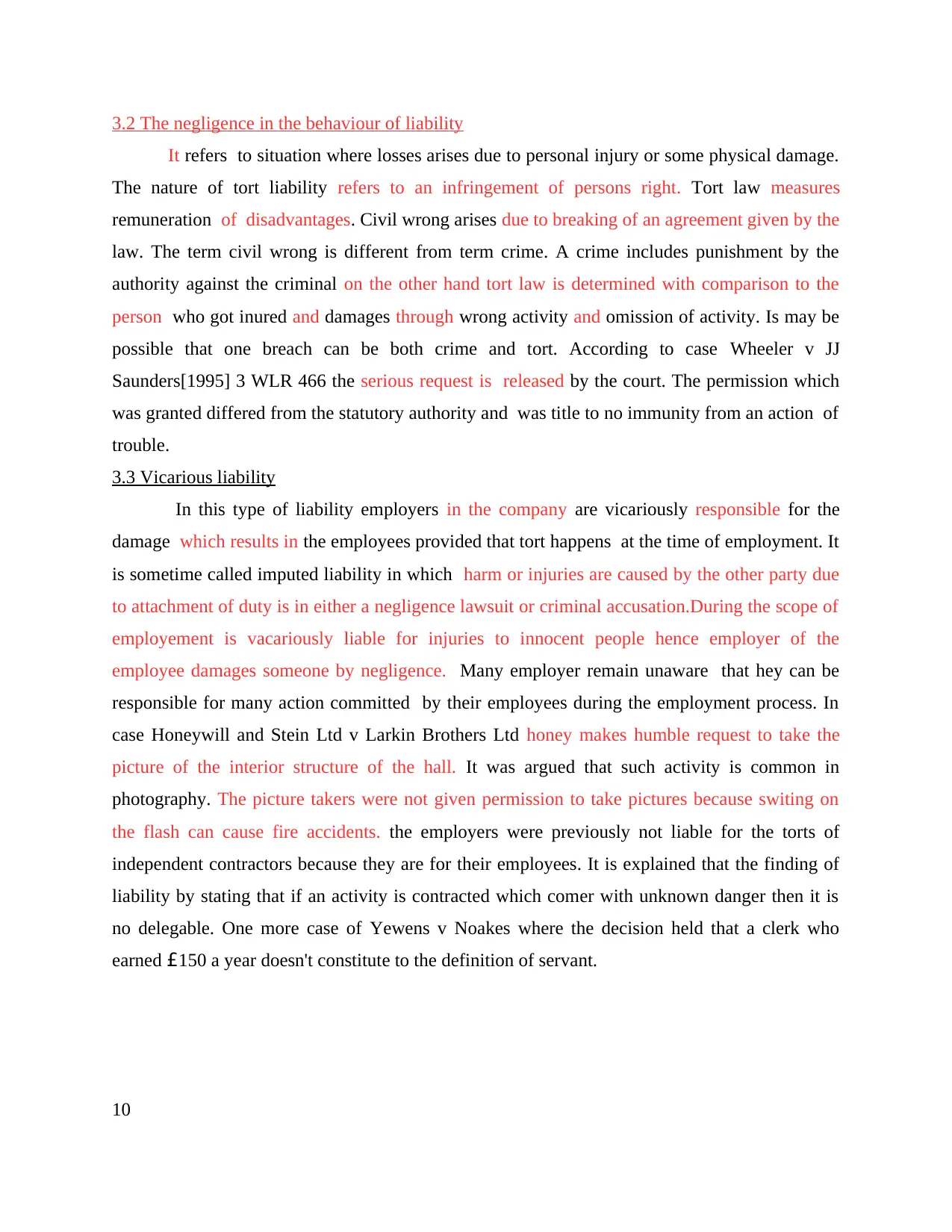
3.2 The negligence in the behaviour of liability
It refers to situation where losses arises due to personal injury or some physical damage.
The nature of tort liability refers to an infringement of persons right. Tort law measures
remuneration of disadvantages. Civil wrong arises due to breaking of an agreement given by the
law. The term civil wrong is different from term crime. A crime includes punishment by the
authority against the criminal on the other hand tort law is determined with comparison to the
person who got inured and damages through wrong activity and omission of activity. Is may be
possible that one breach can be both crime and tort. According to case Wheeler v JJ
Saunders[1995] 3 WLR 466 the serious request is released by the court. The permission which
was granted differed from the statutory authority and was title to no immunity from an action of
trouble.
3.3 Vicarious liability
In this type of liability employers in the company are vicariously responsible for the
damage which results in the employees provided that tort happens at the time of employment. It
is sometime called imputed liability in which harm or injuries are caused by the other party due
to attachment of duty is in either a negligence lawsuit or criminal accusation.During the scope of
employement is vacariously liable for injuries to innocent people hence employer of the
employee damages someone by negligence. Many employer remain unaware that hey can be
responsible for many action committed by their employees during the employment process. In
case Honeywill and Stein Ltd v Larkin Brothers Ltd honey makes humble request to take the
picture of the interior structure of the hall. It was argued that such activity is common in
photography. The picture takers were not given permission to take pictures because switing on
the flash can cause fire accidents. the employers were previously not liable for the torts of
independent contractors because they are for their employees. It is explained that the finding of
liability by stating that if an activity is contracted which comer with unknown danger then it is
no delegable. One more case of Yewens v Noakes where the decision held that a clerk who
earned £150 a year doesn't constitute to the definition of servant.
10
It refers to situation where losses arises due to personal injury or some physical damage.
The nature of tort liability refers to an infringement of persons right. Tort law measures
remuneration of disadvantages. Civil wrong arises due to breaking of an agreement given by the
law. The term civil wrong is different from term crime. A crime includes punishment by the
authority against the criminal on the other hand tort law is determined with comparison to the
person who got inured and damages through wrong activity and omission of activity. Is may be
possible that one breach can be both crime and tort. According to case Wheeler v JJ
Saunders[1995] 3 WLR 466 the serious request is released by the court. The permission which
was granted differed from the statutory authority and was title to no immunity from an action of
trouble.
3.3 Vicarious liability
In this type of liability employers in the company are vicariously responsible for the
damage which results in the employees provided that tort happens at the time of employment. It
is sometime called imputed liability in which harm or injuries are caused by the other party due
to attachment of duty is in either a negligence lawsuit or criminal accusation.During the scope of
employement is vacariously liable for injuries to innocent people hence employer of the
employee damages someone by negligence. Many employer remain unaware that hey can be
responsible for many action committed by their employees during the employment process. In
case Honeywill and Stein Ltd v Larkin Brothers Ltd honey makes humble request to take the
picture of the interior structure of the hall. It was argued that such activity is common in
photography. The picture takers were not given permission to take pictures because switing on
the flash can cause fire accidents. the employers were previously not liable for the torts of
independent contractors because they are for their employees. It is explained that the finding of
liability by stating that if an activity is contracted which comer with unknown danger then it is
no delegable. One more case of Yewens v Noakes where the decision held that a clerk who
earned £150 a year doesn't constitute to the definition of servant.
10
Paraphrase This Document
Need a fresh take? Get an instant paraphrase of this document with our AI Paraphraser
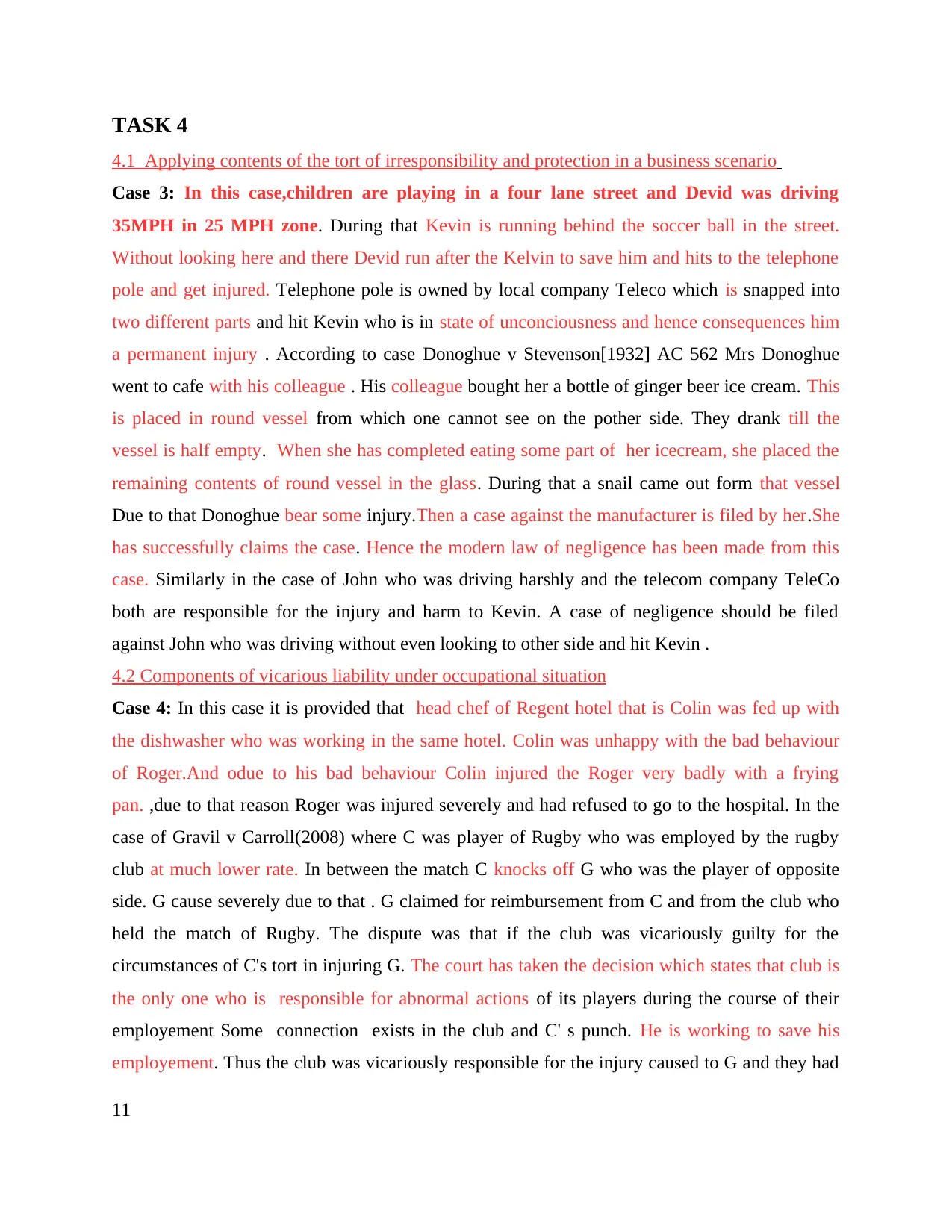
TASK 4
4.1 Applying contents of the tort of irresponsibility and protection in a business scenario
Case 3: In this case,children are playing in a four lane street and Devid was driving
35MPH in 25 MPH zone. During that Kevin is running behind the soccer ball in the street.
Without looking here and there Devid run after the Kelvin to save him and hits to the telephone
pole and get injured. Telephone pole is owned by local company Teleco which is snapped into
two different parts and hit Kevin who is in state of unconciousness and hence consequences him
a permanent injury . According to case Donoghue v Stevenson[1932] AC 562 Mrs Donoghue
went to cafe with his colleague . His colleague bought her a bottle of ginger beer ice cream. This
is placed in round vessel from which one cannot see on the pother side. They drank till the
vessel is half empty. When she has completed eating some part of her icecream, she placed the
remaining contents of round vessel in the glass. During that a snail came out form that vessel
Due to that Donoghue bear some injury.Then a case against the manufacturer is filed by her.She
has successfully claims the case. Hence the modern law of negligence has been made from this
case. Similarly in the case of John who was driving harshly and the telecom company TeleCo
both are responsible for the injury and harm to Kevin. A case of negligence should be filed
against John who was driving without even looking to other side and hit Kevin .
4.2 Components of vicarious liability under occupational situation
Case 4: In this case it is provided that head chef of Regent hotel that is Colin was fed up with
the dishwasher who was working in the same hotel. Colin was unhappy with the bad behaviour
of Roger.And odue to his bad behaviour Colin injured the Roger very badly with a frying
pan. ,due to that reason Roger was injured severely and had refused to go to the hospital. In the
case of Gravil v Carroll(2008) where C was player of Rugby who was employed by the rugby
club at much lower rate. In between the match C knocks off G who was the player of opposite
side. G cause severely due to that . G claimed for reimbursement from C and from the club who
held the match of Rugby. The dispute was that if the club was vicariously guilty for the
circumstances of C's tort in injuring G. The court has taken the decision which states that club is
the only one who is responsible for abnormal actions of its players during the course of their
employement Some connection exists in the club and C' s punch. He is working to save his
employement. Thus the club was vicariously responsible for the injury caused to G and they had
11
4.1 Applying contents of the tort of irresponsibility and protection in a business scenario
Case 3: In this case,children are playing in a four lane street and Devid was driving
35MPH in 25 MPH zone. During that Kevin is running behind the soccer ball in the street.
Without looking here and there Devid run after the Kelvin to save him and hits to the telephone
pole and get injured. Telephone pole is owned by local company Teleco which is snapped into
two different parts and hit Kevin who is in state of unconciousness and hence consequences him
a permanent injury . According to case Donoghue v Stevenson[1932] AC 562 Mrs Donoghue
went to cafe with his colleague . His colleague bought her a bottle of ginger beer ice cream. This
is placed in round vessel from which one cannot see on the pother side. They drank till the
vessel is half empty. When she has completed eating some part of her icecream, she placed the
remaining contents of round vessel in the glass. During that a snail came out form that vessel
Due to that Donoghue bear some injury.Then a case against the manufacturer is filed by her.She
has successfully claims the case. Hence the modern law of negligence has been made from this
case. Similarly in the case of John who was driving harshly and the telecom company TeleCo
both are responsible for the injury and harm to Kevin. A case of negligence should be filed
against John who was driving without even looking to other side and hit Kevin .
4.2 Components of vicarious liability under occupational situation
Case 4: In this case it is provided that head chef of Regent hotel that is Colin was fed up with
the dishwasher who was working in the same hotel. Colin was unhappy with the bad behaviour
of Roger.And odue to his bad behaviour Colin injured the Roger very badly with a frying
pan. ,due to that reason Roger was injured severely and had refused to go to the hospital. In the
case of Gravil v Carroll(2008) where C was player of Rugby who was employed by the rugby
club at much lower rate. In between the match C knocks off G who was the player of opposite
side. G cause severely due to that . G claimed for reimbursement from C and from the club who
held the match of Rugby. The dispute was that if the club was vicariously guilty for the
circumstances of C's tort in injuring G. The court has taken the decision which states that club is
the only one who is responsible for abnormal actions of its players during the course of their
employement Some connection exists in the club and C' s punch. He is working to save his
employement. Thus the club was vicariously responsible for the injury caused to G and they had
11
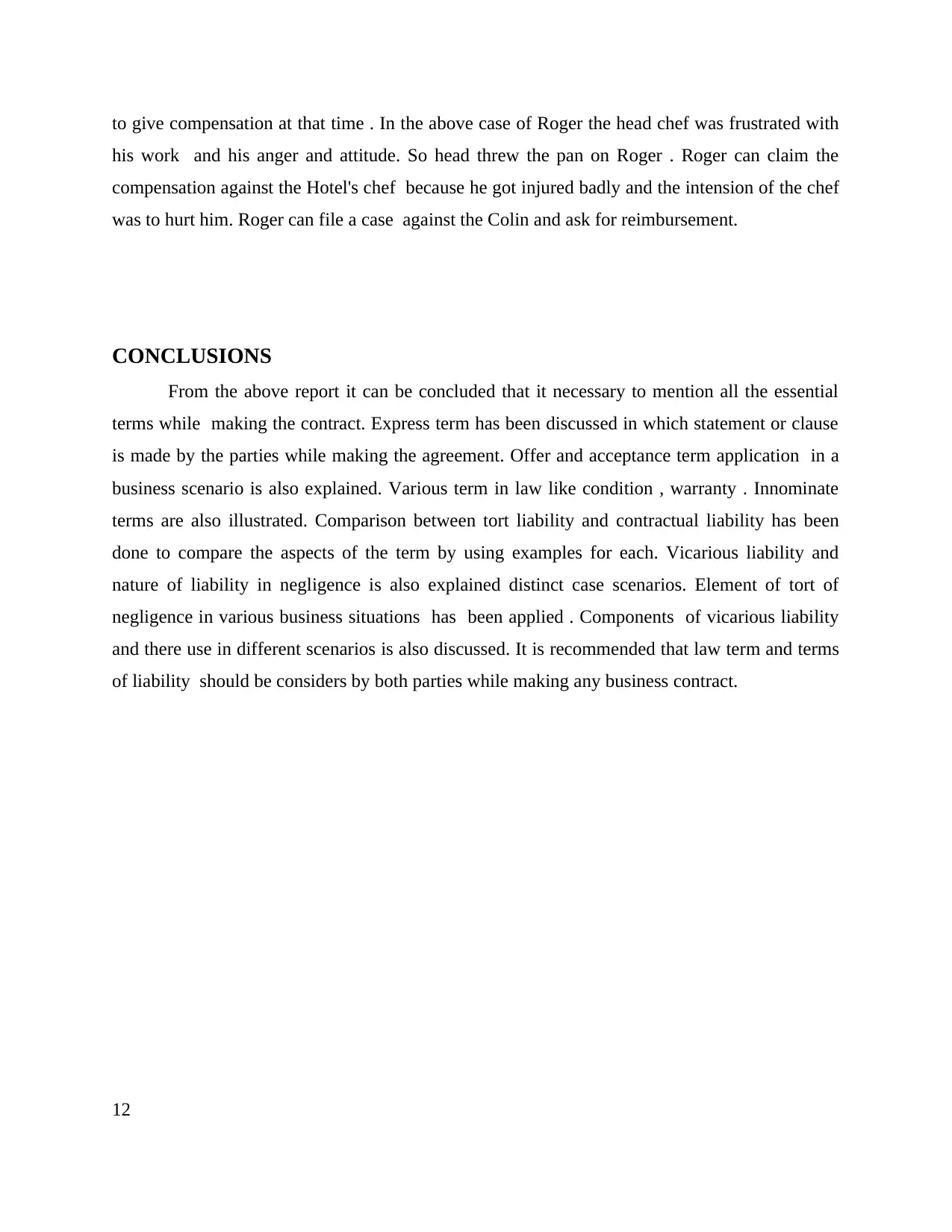
to give compensation at that time . In the above case of Roger the head chef was frustrated with
his work and his anger and attitude. So head threw the pan on Roger . Roger can claim the
compensation against the Hotel's chef because he got injured badly and the intension of the chef
was to hurt him. Roger can file a case against the Colin and ask for reimbursement.
CONCLUSIONS
From the above report it can be concluded that it necessary to mention all the essential
terms while making the contract. Express term has been discussed in which statement or clause
is made by the parties while making the agreement. Offer and acceptance term application in a
business scenario is also explained. Various term in law like condition , warranty . Innominate
terms are also illustrated. Comparison between tort liability and contractual liability has been
done to compare the aspects of the term by using examples for each. Vicarious liability and
nature of liability in negligence is also explained distinct case scenarios. Element of tort of
negligence in various business situations has been applied . Components of vicarious liability
and there use in different scenarios is also discussed. It is recommended that law term and terms
of liability should be considers by both parties while making any business contract.
12
his work and his anger and attitude. So head threw the pan on Roger . Roger can claim the
compensation against the Hotel's chef because he got injured badly and the intension of the chef
was to hurt him. Roger can file a case against the Colin and ask for reimbursement.
CONCLUSIONS
From the above report it can be concluded that it necessary to mention all the essential
terms while making the contract. Express term has been discussed in which statement or clause
is made by the parties while making the agreement. Offer and acceptance term application in a
business scenario is also explained. Various term in law like condition , warranty . Innominate
terms are also illustrated. Comparison between tort liability and contractual liability has been
done to compare the aspects of the term by using examples for each. Vicarious liability and
nature of liability in negligence is also explained distinct case scenarios. Element of tort of
negligence in various business situations has been applied . Components of vicarious liability
and there use in different scenarios is also discussed. It is recommended that law term and terms
of liability should be considers by both parties while making any business contract.
12
⊘ This is a preview!⊘
Do you want full access?
Subscribe today to unlock all pages.

Trusted by 1+ million students worldwide
1 out of 15
Related Documents
Your All-in-One AI-Powered Toolkit for Academic Success.
+13062052269
info@desklib.com
Available 24*7 on WhatsApp / Email
![[object Object]](/_next/static/media/star-bottom.7253800d.svg)
Unlock your academic potential
Copyright © 2020–2025 A2Z Services. All Rights Reserved. Developed and managed by ZUCOL.





